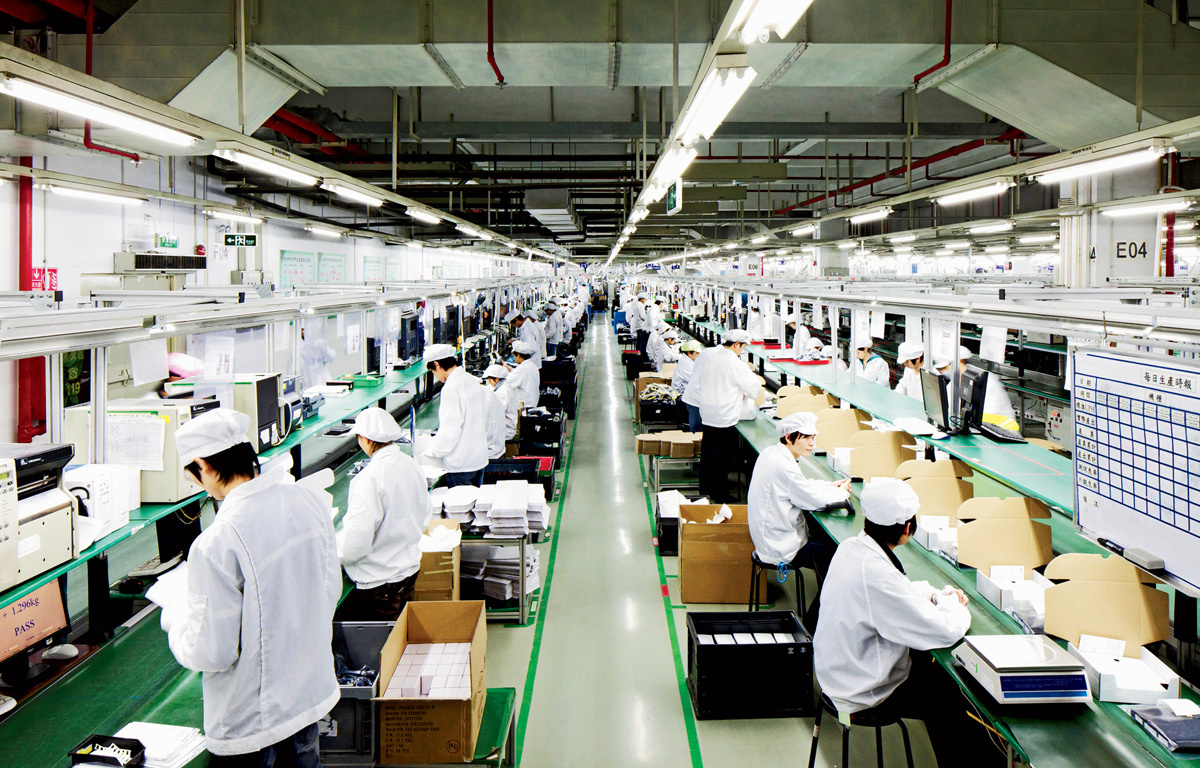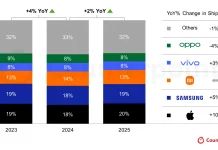Después de los datos financieros de Apple durante los meses de enero, febrero y marzo de 2019 todos nos quedamos con ganas de saber cuántos iPhones podrían haber vendido durante ese período de tiempo. Tanto en el anterior reporte de resultados económicos como en éste último, Apple no ha dado datos de ventas de iPhones o iPads, ni los dará más, ya que han tomado la decisión de ocultarlos deliberadamente al considerarlos un dato que podría ayudar a su competencia, al igual que hacían antes, por ejemplo, con los datos de ventas del Apple Watch.

Por esa razón, ahora la única manera de tener una vaga idea de cuántos iPhones podrían estar vendiéndose es leer los reportes de empresas analistas de mercado como IHS Markit, que nos da la cifra de 43,8 millones de iPhones enviados a tiendas durante esos primeros tres meses de este año 2019.
Se habla de envíos a tiendas porque los datos que obtienen de la cadena de producción y distribución del iPhone sólo tienen en cuenta los envíos (es decir, unidades fabricadas), ya que obviamente sólo Apple puede saber cuantos se venden en su web o en sus tiendas físicas.
El dato que IHS nos da es el más optimista de todas las estimaciones, a pesar de lo cual es una bajada del 16% respecto al mismo trimestre del año pasado, cuando enviaron 52,2 millones de iPhones. En total, teniendo en cuenta estos 43,8 millones de unidades, Apple tendría el 14% del total de smartphones vendidos, que en su conjunto ha bajado en ventas un 6,3%, confirmando una ralentización general del mercado de los smartphones a nivel mundial. Está claro que, ahora, los usuarios tardamos más tiempo en renovar nuestro smarpthone porque el que tenemos ha incrementado su durabilidad considerablemente, tanto a nivel de hardware como a nivel de software. Estamos llegando a la madurez de este mercado, después de una aceleración vertiginosa que comenzó con la presentación y lanzamiento del primer iPhone original en el año 2007. Esta ralentización del mercado una de las razones por las que los smartphones ahora son bastante más caros que antes.
A pesar de todo, Apple ha disfrutado de una subida del 6% en valoración bursátil después de su reporte financiero para este primer trimestre del año, el segundo trimestre fiscal (Q2) del año.
De todos los fabricantes de smartphones, Huawei es el único que incrementa envíos y además lo hace notablemente, sobre todo en China, su tierra natal. El dato llega cuando muchos gobiernos en todo el mundo están cesando de utilizar sus dispositivos por miedo al espionaje industrial chino.
Estos son los números de envíos de cada fabricante de smartphones a nivel mundial, según datos de IHS.

Aquí os dejamos la nota de prensa original publicada por IHS, en inglés, con todos estos datos.
Huawei builds on 2018 momentum with strong first-quarter performance in the smartphone market
By Jusy Hong, research and analysis director & Gerrit Schneemann, senior analyst, IHS Markit
Following four consecutive quarters of negative growth in 2018, the global smartphone market continued to struggle in the first quarter of 2019, suffering a 6.3 percent year-over-year decline in shipments.
Smartphone shipments totaled 323.8 million units in the first quarter of 2019, down from 345.6 million during the first quarter of 2018 according to preliminary smartphone data by IHS Markit.
Huawei steals the smartphone show
Samsung Electronics maintained the top rank in the smartphone market in terms of volume with shipments of 70.8 million units during the quarter. However, the South Korean company was not the biggest story of the quarter.
Instead, the headliner was China’s Huawei, which shipped 59.1 million smartphones in the first quarter. This almost matched Huawei’s strong performance in the fourth quarter of 2018, when the company shipped 60.5 million units. The company’s shipments were up 50 percent year-over-year, making Huawei one of just three OEMs posting growth during the past quarter.
The other OEMs attaining growth in the first quarter were Vivo and Tecno.
Huawei’s performance is particularly impressive in light of the headwinds the company faces from the United States and other countries regarding 5G network roll-out activity. The company continues to expand in Europe, the Middle East and Africa, growing by more than 60 percent in the region. Moreover, Huawei is continuing to lead in its home market, shipping 30 million units in China, up 42 percent year-over-year.
With its Huawei and Honor brands, Huawei has been able to deliver new design configurations in 2018 and early 2019 that allow it to offer features preferred by users, such as enhanced camera capabilities. In Europe, Huawei is now a well-established brand, competing on even footing with Samsung and Apple in the high-end, while expanding into other price segments as well. Huawei is continuing to successfully separate its network business challenges from its consumer-devices business unit.
Samsung’s loss: Huawei’s gain
Samsung’s negative growth from 2018 has spilled into 2019, with the company’s shipments declining 9 percent year-over-year in the first quarter. The tech giant’s market share declined from 23 percent in the first quarter of 2018 to 22 percent in the first quarter of 2019.
Huawei, in contrast, saw its market share reach 18 percent, the highest share ever, up from 11 percent a year ago.
For Samsung, it will be important to continue pursuing its strategy from 2018 and focus on integration of new and innovative technologies in broad parts of its portfolio. Effective competition with Chinese OEMs will rely on fast execution and nimble adjustments.
Apple faces smartphone challenges
After struggling in the fourth quarter of 2018, Apple continued to face challenges in the first quarter of 2019. Apple shipped 43.8 million iPhones in the first quarter, down 16 percent from 52.2 million units during the previous year.
The fourth quarter likely left Apple with excess inventory, creating an incentive for the company to use more generous trade-in offers and more financing options in as many regions as possible. While slightly reducing prices in China might encourage some buyers, Apple faces the underlying challenge of charging premium pricing in a maturing smartphone market. As a result, Apple may not be able to find short-term fixes for its problems.
Smartphone winners and losers
Vivo shipped 24.3 million smartphones during the quarter, up from 21.2 million units in the first quarter of 2018. The company’s 14 percent year-over-year growth was the second highest shipment increase after Huawei.
OPPO, on the other hand, saw shipments decline to 25.2 million units, down 3 percent from 25.9 million units during the first quarter of 2018.
Xiaomi remains under pressure from OPPO and Vivo. During the quarter, Xiaomi shipped 24.7 million units, down from 29.3 million units in the first quarter of 2018 — a 16 percent decline year-over-year. India continues to play a central role for Xiaomi’s business outside of China. However, OPPO and vivo are also expanding in the country. In OPPO’s case, a greater focus has been placed on expansion in Europe and India than previously.
Market concentration continues to intensify: The top-3 smartphone brands in 2019 took 54 percent market share. The top-6 took 77 percent share.
Tough times continue for many smartphone makers
For many other smartphone brands, business conditions continue to be difficult, with few signs of a silver lining on the horizon.
LG continues to struggle with its mobile handset business unit. The company’s latest flagship devices lack differentiation, and as a result, they continue to be lost among the sea of new models. Tecno, a popular smartphone brand in Africa, is now facing severe competition from Huawei in the region.
The roll-out of 5G handsets began in the first quarter, but they arrived too late in the quarter to impact results. Furthermore, only a few handsets are currently available to consumers in markets where 5G networks have launched. The activity surrounding more 5G network launches will continue throughout the year, but first-generation 5G handsets are premium devices, a pricing segment already testing the limits of consumer acceptance.
























